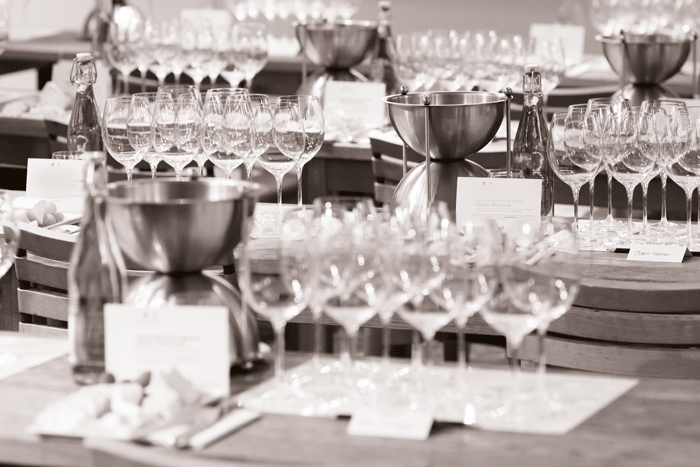How to taste wine – Lunch & Learn 1
Author: Rebecca Lamont
It’s easy to be a good taster. Like anything (football, playing the flute, baking bread) the more you have a go, the more expert you become.
Our Wine School ethos of learning is that we are all good tasters – when you realise this, it can be incredibly exciting and you can fall in love with wine.
How do we go about bringing out your inner expertise? We give you the chance to say what you think as you experience a wine.
The easiest way to do this is to have two wines in front of you made from the same grape variety, but from different areas. If you have glasses with stems, then hold by the stem so as not to change the temperature of the wine. If the glass is free from patterns you can marvel at the colour.
All you are basically asking yourself is: “How do these two wines differ from each other? Is one richer, smoother, softer, more bitter, acidic or sharp (we could go on and on…) than the other?”
So, for instance, when you talk about the sweetness of the wine, your brain is cleverly analysing how ripe the grapes were when they were picked. In the winery, the sugar is usually transformed into alcohol and then is technically without sugar. Wine professionals sensing on the same feature would describe the wine as ‘dry from a warm climate’.
Interestingly, if your wine is red and it strikes you as dry, what you may be experiencing is a drying sensation, especially around your gums. Your brain, through your sensory perception, is picking up the tannins that can be found in red wine. These are good parts to the wine, busily fighting off oxygen so that the wine does does not turn into vinegar too quickly.
If you’ve got a young, premium red, the tannins will be more noticeable. This is why many of us leave the wine to age. The thinking is that the tannins will soften with time and their impact lessens with richer food.
When you talk about a wine being ‘tart’ or ‘fresh’ or sometimes even dry (if it is white wine) your brain is working out how much acidity there is in the wine. This is important to us, because acidity is a preservative: it keeps the wine fresh and appealing, cleanses the palate after food and also helps your digestion.
The weight of the wine is something you tend to notice too. (Think about the difference in weight between water and olive oil in your palate.) This is because often we prefer having heavier wines with heavier food and lighter wines with lighter food. Weight is also often linked to alcohol which is the sensation of warmth you get at the back of the throat.
Don’t get hung up on descriptors for aromas and flavours – just say to yourself, “What does this remind me of?” Make a note (however esoteric or outrageous you think your descriptions are) and also listen to what others have to say too. Slowly but surely you will find ways of expressing yourself. A note on etiquette: wearing perfume or aftershave is frowned up in serious wine tastings, as these aromas can be overbearing when trying to concentrate on the often more delicate wine aromas.
The wine courses at the Wine School allow plenty of time to discuss, practice and develop ideas – which are all part of the pleasure of tasting wine. So remember: if you’re an individual who’s curious about wine, then discovering your own expertise should be great fun.
If you are interested in finding out more, join us at Wine School for the new Lunch & Learn series of events. To unleash your own wine-tasting expertise, Becky will be hosting her excellent Introduction to Wine Tasting session on 30th October.



